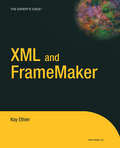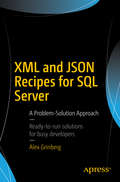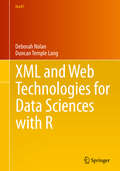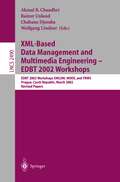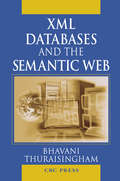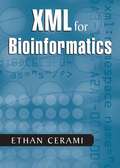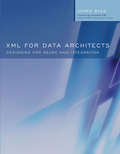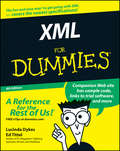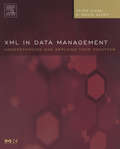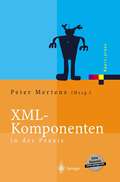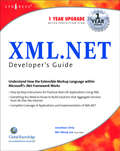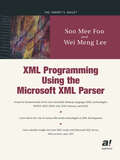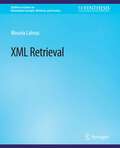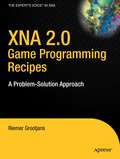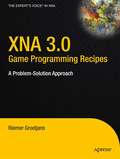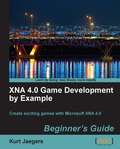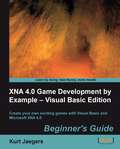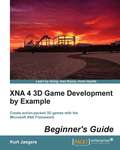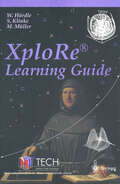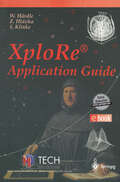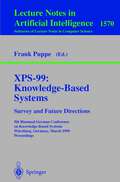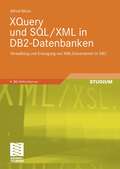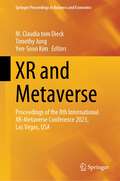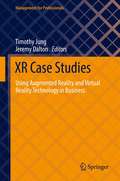- Table View
- List View
XML and FrameMaker
by Kay Ethier* This book appeals to a professional audience: Writers, database administrators, developers, and production staff, all of which have to capture or emit XML from existing documents or databases. * Describes the connection between XML and publishing; Explains how to use XML to create documents that may be published to many other formats. * Shows how to build an "XML round trip" for Adobe FrameMaker 7; Explains how FrameMaker’s powerful formatting features lend themselves to publishing of XML documents—without rework.
XML and JSON Recipes for SQL Server: A Problem-Solution Approach
by Alex GrinbergQuickly find solutions to dozens of common problems encountered while using XML and JSON features that are built into SQL Server. Content is presented in the popular problem-solution format. Look up the problem that you want to solve. Read the solution. Apply the solution directly in your own code. Problem solved!This book shows how to take advantage of XML and JSON to share data and automate tasks. JSON is commonly used to move data back and forth between the database and front-end applications, often running in a browser. This book shows all you need to know about transforming query results into JSON format, and back again. Also covered are the processes and techniques for moving data into and out of XML format for business intelligence and other purposes, such as when transferring data from a reporting system into a data warehouse, or between different database brands such as between SQL Server and Oracle.Microsoft intensively implements XML in SQL Server, and in many related products. Execution plans are generated in XML format, and this book shows you how to parse those plans and automate the detection of performance problems. The relatively new Extended Events feature writes tracing data into XML files, and the recipes in this book help in parsing those files. XML is also used in SQL Server's BI tool set, including in SSIS, SSR, and SSAS. XML is used in many configuration files, and is even behind the construction of DDL triggers. In reading this book you’ll dive deeply into the features that allow you to build and parse XML, and also JSON, which is a specific format of XML used to transmit objects in a web-friendly format between a database and its front-end applications.What You Will LearnBuild XML and JSON objects in support of automation and data transferImport and parse XML and JSON from operating system filesBuild appropriate indexes on XML objects to improve query performanceMove data from query result sets into JSON format, and back againAutomate the detection of database performance problems by querying and parsing the database’s own execution plansReplace external and manual JSON processes with SQL Server's internal, JSON functionalityWho This Book Is ForDatabase administrators, .NET developers, business intelligence developers, and other professionals who want a deep and detailed skill set around working with XML and JSON in a SQL Server database environment. Web developers will particularly find the book useful for its coverage of transforming database result sets into JSON text that can be transmitted to front-end web applications.
XML and Web Technologies for Data Sciences with R (Use R!)
by Deborah Nolan Duncan Temple LangWeb technologies are increasingly relevant to scientists working with data, for both accessing data and creating rich dynamic and interactive displays. The XML and JSON data formats are widely used in Web services, regular Web pages and JavaScript code, and visualization formats such as SVG and KML for Google Earth and Google Maps. In addition, scientists use HTTP and other network protocols to scrape data from Web pages, access REST and SOAP Web Services, and interact with NoSQL databases and text search applications. This book provides a practical hands-on introduction to these technologies, including high-level functions the authors have developed for data scientists. It describes strategies and approaches for extracting data from HTML, XML, and JSON formats and how to programmatically access data from the Web. Along with these general skills, the authors illustrate several applications that are relevant to data scientists, such as reading and writing spreadsheet documents both locally and via Google Docs, creating interactive and dynamic visualizations, displaying spatial-temporal displays with Google Earth, and generating code from descriptions of data structures to read and write data. These topics demonstrate the rich possibilities and opportunities to do new things with these modern technologies. The book contains many examples and case-studies that readers can use directly and adapt to their own work. The authors have focused on the integration of these technologies with the R statistical computing environment. However, the ideas and skills presented here are more general, and statisticians who use other computing environments will also find them relevant to their work.Deborah Nolan is Professor of Statistics at University of California, Berkeley.Duncan Temple Lang is Associate Professor of Statistics at University of California, Davis and has been a member of both the S and R development teams.
XML-Based Data Management and Multimedia Engineering - EDBT 2002 Workshops: EDBT 2002 Workshops XMLDM, MDDE, and YRWS, Prague, Czech Republic, March 24-28, 2002, Revised Papers (Lecture Notes in Computer Science #2490)
by Akmal B. Chaudhri Chabane Djeraba Rainer Unland Wolfgang LindnerThis volume comprises papers from the following three workshops that were part of the complete program for the International Conference on Extending Database Technology (EDBT) held in Prague, Czech Republic, in March 2002: XML-Based Data Management (XMLDM) Second International Workshop on Multimedia Data and Document Engineering (MDDE) Young Researchers Workshop (YRWS) Together, the three workshops featured 48 high-quality papers selected from approximately 130 submissions. It was, therefore, difficult to decide on the papers that were to be accepted for presentation. We believe that the accepted papers substantially contribute to their particular fields of research. The workshops were an excellent basis for intense and highly fruitful discussions. The quality and quantity of papers show that the areas of interest for the workshops are highly active. A large number of excellent researchers are working in relevant fields producing research output that is not only of interest to other researchers but also for industry. The organizers and participants of the workshops were highly satisfied with the output. The high quality of the presenters and workshop participants contributed to the success of each workshop. The amazing environment of Prague and the location of the EDBT conference also contributed to the overall success. Last, but not least, our sincere thanks to the conference organizers – the organizing team was always willing to help and if there were things that did not work, assistance was quickly available.
XML Databases and the Semantic Web
by Bhavani ThuraisinghamEfficient access to data, sharing data, extracting information from data, and making use of the information have become urgent needs for today's corporations. With so much data on the Web, managing it with conventional tools is becoming almost impossible. New tools and techniques are necessary to provide interoperability as well as warehousing betw
XML for Bioinformatics
by Ethan CeramiIntroduction The goal of this book is to introduce XML to a bioinformatics audience. It does so by introducing the fundamentals of XML, Document Type De?nitions (DTDs), XML Namespaces, XML Schema, and XML parsing, and illustrating these concepts with speci?c bioinformatics case studies. The book does not assume any previous knowledge of XML and is geared toward those who want a solid introduction to fundamental XML concepts. The book is divided into nine chapters: Chapter 1: Introduction to XML for Bioinformatics. This chapter provides an introduction to XML and describes the use of XML in biological data exchange. A bird’s-eye view of our ?rst case study, the Distributed Annotation System (DAS), is provided and we examine a sample DAS XML document. The chapter concludes with a discussion of the pros and cons of using XML in bioinformatic applications. Chapter 2: Fundamentals of XML and BSML. This chapter introduces the fundamental concepts of XML and the Bioinformatic Sequence Markup Language (BSML). We explore the origins of XML, de?ne basic rules for XML document structure, and introduce XML Na- spaces. We also explore several sample BSML documents and visualize these documents in the TM Rescentris Genomic Workspace Viewer.
XML for Data Architects: Designing for Reuse and Integration (The Morgan Kaufmann Series in Data Management Systems)
by James Bean"The book addresses a sorely missing set of considerations in the real world... This is a very timely book."-Peter Herzum, author of Business Component Factory and CEO of Herzum SoftwareXML is a tremendous enabler for platform agnostic data and metadata exchanges. However, there are no clear processes and techniques specifically focused on the engineering of XML structures to support reuse and integration simplicity, which are of particular importance in the age of application integration and Web services. This book describes the challenges of using XML in a manner that promotes simplification of integration, and a high degree of schema reuse. It also describes the syntactical capabilities of XML and XML Schemas, and the similarities (and in some cases limitations) of XML DTDs. This book presents combinations of architectural and design approaches to using XML as well as numerous syntactical and working examples.* Designed to be read three different ways: skim the margin notes for quick information, or use tables in the appendix to locate sections relevant the to a particular issue, or read cover-to-cover for the in-depth treatment. * Contains numerous tables that describe datatypes supported by the most common DBMSs and map to XML Schema supported data types.* Unique focus on the value added role and processes of the data architect as they apply to enterprise use of XML.
XML For Dummies
by Lucinda Dykes Ed TittelSee how XML works for business needs and RSS feeds Create consistency on the Web, or tag your data for different purposes Tag -- XML is it! XML tags let you share your format as well as your data, and this handy guide will show you how. You'll soon be using this markup language to create everything from Web sites to business forms, discovering schemas and DOCTYPES, wandering the Xpath, teaming up XML with Office 2003, and more. Discover how to * Make information portable * Use XML with Word 2003 * Store different types of data * Convert HTML documents to XHTML * Add CSS to XML * Understand and use DTDs
XML For Dummies
by Lucinda Dykes Ed TittelSee how XML works for business needs and RSS feeds Create consistency on the Web, or tag your data for different purposes Tag -- XML is it! XML tags let you share your format as well as your data, and this handy guide will show you how. You'll soon be using this markup language to create everything from Web sites to business forms, discovering schemas and DOCTYPES, wandering the Xpath, teaming up XML with Office 2003, and more. Discover how to * Make information portable * Use XML with Word 2003 * Store different types of data * Convert HTML documents to XHTML * Add CSS to XML * Understand and use DTDs
XML in Data Management: Understanding and Applying Them Together (The Morgan Kaufmann Series in Data Management Systems)
by Peter Aiken M. David AllenXML in Data Management is for IT managers and technical staff involved in the creation, administration, or maintenance of a data management infrastructure that includes XML. For most IT staff, XML is either just a buzzword that is ignored or a silver bullet to be used in every nook and cranny of their organization. The truth is in between the two. This book provides the guidance necessary for data managers to make measured decisions about XML within their organizations. Readers will understand the uses of XML, its component architecture, its strategic implications, and how these apply to data management.Takes a data-centric view of XMLExplains how, when, and why to apply XML to data management systemsCovers XML component architecture, data engineering, frameworks, metadata, legacy systems, and moreDiscusses the various strengths and weaknesses of XML technologies in the context of organizational data management and integration
XML Net Developers Guide
by SyngressCompete with the big players in today's E-commerce marketplaceElectronic Data Interchange (EDI) has long been the standard for large business enterprises to communicate in the B2B marketplace. However, EDI is a difficult technology - the cost and support of EDI standards is often too much for a small or medium business enterprise to bear. To compete in the current E-commerce marketplace, many organizations are beginning to take an interest in the interoperability that exists between XML (Extensible Markup Language) and EDI. XML .NET Developers Guide is written for information technology professionals responsible for supporting data management in both small and large organizations. This book appeals to both individuals working with an existing EDI environment, and small to medium businesses looking to increase their market presence by competing with current EDI players using XML/EDI.XML/EDI is quickly becoming an industry standard, however there is a noticeable lack of quality reference material for programmers looking to adopt these standards.You can take it with you. The book comes with Syngress' revolutionary Wallet CD containing a printable HTML version of the book, all of the source code, and demo versions of popular XML/EDI translation tools Up to the minute web-based support with solutions@syngress.com
XML Programming Using the Microsoft XML Parser
by Wei-Meng Lee Soo Mee FooXML Programming Using the Microsoft XML Parser is written for programmers interested in XML development using Microsoft technologies. Coupling valuable discussion of the Microsoft XML parser, Windows platform, and XML development software with the numerous core XML technologies, including XSLT, XPATH, SAX, DOM, XML Schema, and SOAP, this book steps beyond the mainstream focus on the theoretical aspects of XML and actually demonstrates the concepts in a real-world development environment. Veteran authors and trainers Soo Mee Foo and Wei Meng Lee intersperse this survey of XML technologies with discussion of topics sure to interest any budding XML developer, providing timely information regarding Web services, ActiveX Data Objects (ADO), and Microsoft SQL Server 2000 XML support. A chapter is also devoted to the Wireless Markup Language (WML), one of the most visible applications of XML technology. No question, XML is one of the rising stars in information technology. XML Programming Using the Microsoft XML Parser offers you what you need to know to get acquainted with the concepts necessary to begin development with this exciting technology.
XML Retrieval (Synthesis Lectures on Information Concepts, Retrieval, and Services)
by Mounia LalmasDocuments usually have a content and a structure. The content refers to the text of the document, whereas the structure refers to how a document is logically organized. An increasingly common way to encode the structure is through the use of a mark-up language. Nowadays, the most widely used mark-up language for representing structure is the eXtensible Mark-up Language (XML). XML can be used to provide a focused access to documents, i.e. returning XML elements, such as sections and paragraphs, instead of whole documents in response to a query. Such focused strategies are of particular benefit for information repositories containing long documents, or documents covering a wide variety of topics, where users are directed to the most relevant content within a document. The increased adoption of XML to represent a document structure requires the development of tools to effectively access documents marked-up in XML. This book provides a detailed description of query languages, indexing strategies, ranking algorithms, presentation scenarios developed to access XML documents. Major advances in XML retrieval were seen from 2002 as a result of INEX, the Initiative for Evaluation of XML Retrieval. INEX, also described in this book, provided test sets for evaluating XML retrieval effectiveness. Many of the developments and results described in this book were investigated within INEX. Table of Contents: Introduction / Basic XML Concepts / Historical Perspectives / Query Languages / Indexing Strategies / Ranking Strategies / Presentation Strategies / Evaluating XML Retrieval Effectiveness / Conclusions
XNA 2.0 Game Programming Recipes: A Problem-Solution Approach
by Riemer GrootjansIn this book, XNA expert Reimer Grootjans brings together a selection of the hottest quick-start recipes in XNA programming for the Xbox and Windows PC. Advanced XNA programmers, experienced coders new to games development, and even complete beginners will find XNA Game Programming Recipes an invaluable companion when building games for fun or as commercial products. Numerous problem-solving recipes cover topics from cameras and angles, to textures, models, and lighting and shadowing, and will get you over the common hurdles encountered in both 2D and 3D XNA application design.
XNA 3.0 Game Programming Recipes: A Problem-Solution Approach
by Riemer GrootjansJoin the game development revolution today! XNA 3.0 greatly simplifies the development of your own games, lowering the barrier for programmers to get into game development. In XNA, you can start coding your games from the very start, a true revelation compared to other game programming environments. XNA doesn't sacrifice power for this ease of use—it is built entirely on DirectX technology. Completely updated for XNA 3.0, expert Riemer Grootjans brings together a selection of the hottest recipes in XNA programming for the Xbox 360, PC, and Zune. Advanced XNA programmers, experienced coders new to game development, and even complete beginners will find XNA 3.0 Game Programming Recipes an invaluable companion whether building games for fun or as commercial products.
XNA 4.0 Game Development by Example: Beginner's Guide
by Kurt JaegersThis book is a step-by-step tutorial that includes complete source code for all of the games covered. It adopts an engaging style to teach all the game development concepts. Each block of code is explained, and game development concepts are diagrammed and covered in detail. Each game begins with a concept description and concludes with suggestions for expanding on the finished game. If you are an aspiring game developer who wants to take a shot at creating games for the Microsoft Windows platform with the XNA Framework, then this book is for you. Using this book, you can get started with creating games without any game development experience. A basic knowledge of C# would be helpful to kick-start your game development, but it's not essential.
XNA 4.0 Game Development by Example: Beginner's Guide - Visual Basic Edition Beginner's Guide
by Kurt JaegersIn DetailXNA Game Studio enables hobbyists and independent game developers to easily create video games, and now gives that power to Visual Basic developers. XNA lets you bring your creations to life on Windows, the Xbox 360 and the Windows Phone platforms. The latest release of XNA has added support to Visual Basic and therefore, Visual Basic developers now have the power to give life to their creativity with XNA.This book covers both the concepts and the implementations necessary to get you started on bringing your own creations to life with XNA. It presents four different games, including a puzzler, space shooter, multi-axis shoot 'em up, and a jump-and-run platformer. Each game introduces new concepts and techniques to build a solid foundation for your own ideas and creativity.This book details the creation of four games, all in different styles, from start to finish using Visual Basic and the Microsoft XNA framework. Beginning with the basics of drawing images to the screen, the book then incrementally introduces sprite animation, particles, sound effects, tile-based maps, and path finding. It then explores combining XNA with Windows Forms to build an interactive map editor, and builds a platform-style game using the editor-generated maps. Finally, the book covers the considerations necessary for deploying your games to the Xbox 360 platform.By the end of the book, you will have a solid foundation of game development concepts and techniques as well as working sample games to extend and innovate upon. You will have the knowledge necessary to create games that you can complete without an army of fellow game developers at your back.A step-by-step tutorial for using Visual Basic with Microsoft XNA to create four different styles of video games.ApproachThis book is a step-by-step tutorial that includes complete source code for all of the games covered. It adopts an engaging style to teach all the game development concepts. Each block of code is explained, and game development concepts are diagrammed and covered in detail. Each game begins with a concept description and concludes with suggestions for expanding on the finished game.Who this book is forIf you are an aspiring game developer who wants to take a shot at creating games for the Microsoft Windows platform with the XNA Framework, then this book is for you. Using this book, you can get started with creating games without any game development experience. A basic knowledge of Visual Basic would be needed to kickstart your game development.
XNA 4 3D Game Development by Example Beginner's Guide: Beginner's Guide
by Kurt JaegersIn DetailMove beyond the world of flat 2D-based game development and discover how to create your own exciting 3D games with Microsoft XNA 4.0. Create a 3D maze, fire shells at enemy tanks, and drive a rover on the surface of Mars while being attacked by alien saucers."XNA 4 3D Game Development by Example: Beginner's Guide" takes you step-by-step through the creation of three different 3D video games with Microsoft XNA 4.0. Learn by doing as you explore the worlds of 3D graphics and game design.This book takes a step-by-step approach to building 3D games with Microsoft XNA, describing each section of code in depth and explaining the topics and concepts covered in detail. From the basics of a 3D camera system to an introduction to writing DirectX shader code, the games in this book cover a wide variety of both 3D graphics and game design topics. Generate random mazes, load and animate 3D models, create particle-based explosions, and combine 2D and 3D techniques to build a user interface."XNA 4 3D Game Development by Example: Beginner's Guide" will give you the knowledge to bring your own 3D game creations to life.ApproachThis book is a step-by-step tutorial that includes complete source code for all of the games covered. It adopts an engaging style to teach all the game development concepts. Each block of code is explained, and game development concepts are diagrammed and covered in detail. Each game begins with a concept description and concludes with suggestions for expanding on the finished game.Who this book is forThis book is intended for readers who want to create 3D games using the XNA Framework. Basic knowledge of the C# programming language and 2D XNA concepts are helpful, but not required.
XploRe — Learning Guide: Learning Guide
by W. Härdle S. Klinke M. MüllerIt is generally accepted that training in statistics must include some exposure to the mechanics of computational statistics. This learning guide is intended for beginners in computer-aided statistical data analysis. The prerequisites for XploRe - the statistical computing environment - are an introductory course in statistics or mathematics. The reader of this book should be familiar with basic elements of matrix algebra and the use of HTML browsers. This guide is designed to help students to XploRe their data, to learn (via data interaction) about statistical methods and to disseminate their findings via the HTML outlet. The XploRe APSS (Auto Pilot Support System) is a powerful tool for finding the appropriate statistical technique (quantlet) for the data under analysis. Homogeneous quantlets are combined in XploRe into quantlibs. The XploRe language is intuitive and users with prior experience of other sta tistical programs will find it easy to reproduce the examples explained in this guide. The quantlets in this guide are available on the CD-ROM as well as on the Internet. The statistical operations that the student is guided into range from basic one-dimensional data analysis to more complicated tasks such as time series analysis, multivariate graphics construction, microeconometrics, panel data analysis, etc. The guide starts with a simple data analysis of pullover sales data, then in troduces graphics. The graphics are interactive and cover a wide range of dis plays of statistical data.
XploRe® - Application Guide
by W. Härdle Z. Hlavka S. KlinkeThis book offers a detailed application guide to XploRe - an interactive statistical computing environment. As a guide it contains case studies of real data analysis situations. It helps the beginner in statistical data analysis to learn how XploRe works in real life applications. Many examples from practice are discussed and analysed in full length. Great emphasis is put on a graphic based understanding of the data interrelations. The case studies include: Survival modelling with Cox's proportional hazard regression, Vitamin C data analysis with Quantile Regression, and many others.
XPS-99: 5th Biannual German Conference on Knowledge-Based Systems, Würzburg, Germany, March 3-5, 1999, Proceedings (Lecture Notes in Computer Science #1570)
by Frank PuppeA special year like 1999 invites one to draw a balance of what has been achieved in the roughly 30 years of research and development in knowledge based systems (still abbreviated as XPS following the older term “expert systems”) and to take a look at th what the future may hold. For the 5 German conference on knowledge-based systems we therefore asked current and former speakers of the four working groups (FG’s) in the subdivision of knowledge-based systems (FA 1.5) of the German association of Informatics (GI) to present a survey of and future prospects for their respective fields: knowledge engineering, diagnosis, configuration, and case-based reasoning. An additional 14 technical papers deal with current topics in knowledge-based systems with an equal emphasis on methods and applications. They are selected from more than 50 papers accepted in the 4 parallel workshops of XPS-99: a) Knowledge Management, Organizational Memory and Reuse, b) various fields of applications, c) the traditional PuK Workshop (planning and configuration), and d) the GWCBR (German workshop on case-based reasoning). The other papers presented at these workshops are not included in this volume but are available as internal reports of Würzburg university together with the exhibition guide that emphasizing tool support for building knowledge based systems.
XQuery und SQL/XML in DB2-Datenbanken: Verwaltung und Erzeugung von XML-Dokumenten in DB2
by Alfred MoosIn den modernen universellen Datenbanken ist die Verwaltung von herkömmlichen Daten und die Verwaltung von XML-Dokumenten zusammengewachsen. Jeder zukunftsorientierte Informatiker benötigt über die neuen Möglichkeiten zumindest mittelmäßige Kenntnisse oder noch besser profunde Qualifikationen. Dokumente sind, im Gegensatz zu herkömmlichen relationalen Daten, hierarchische Baumstrukturen. Der Umgang mit ihnen verlangt von Informatikern eine neue hierarchische Denkweise. Ihre systematische Einführung und Einübung mit den gebotenen Möglichkeiten von SQL3 und XQuery in DB2 ist zentraler Gegenstand des Buches.
XR and Metaverse: Proceedings of the 8th International XR-Metaverse Conference 2023, Las Vegas, USA (Springer Proceedings in Business and Economics)
by M. Claudia tom Dieck Timothy Jung Yen-Soon KimThis book offers a comprehensive collection of the latest research presented at the 8th International XR-Metaverse Conference, held in Las Vegas, USA in 2023. Its goal is to bridge the gap between academia and industry by advancing the state of the art in metaverse, XR, AI-based AR and VR technologies, and by exploring their applications in various fields such as business, marketing, education, health care, tourism, events, fashion, entertainment, retail, and the gaming industry. Including contributions by prominent XR scholars from around the globe, the book addresses a wide range of significant topics concerning XR and the metaverse. Showcasing cutting-edge research outputs, it will be of interest to both academics and practitioners eager to catch up on the latest developments in this rapidly evolving field.
XR Case Studies: Using Augmented Reality and Virtual Reality Technology in Business (Management for Professionals)
by Timothy Jung Jeremy DaltonThis book presents a comprehensive collection of case studies on augmented reality and virtual realty (AR/VR) applications in various industries. Augmented reality and virtual reality are changing the business landscape, providing opportunities for businesses to offer unique services and experiences to their customers. The case studies provided in this volume explore business uses of the technology across multiple industries such as healthcare, tourism, hospitality, events, fashion, entertainment, retail, education and video gaming. The book includes solutions of different maturities as well as those from startups to large enterprises thereby providing a thorough view of how augmented reality and virtual reality can be used in business.
